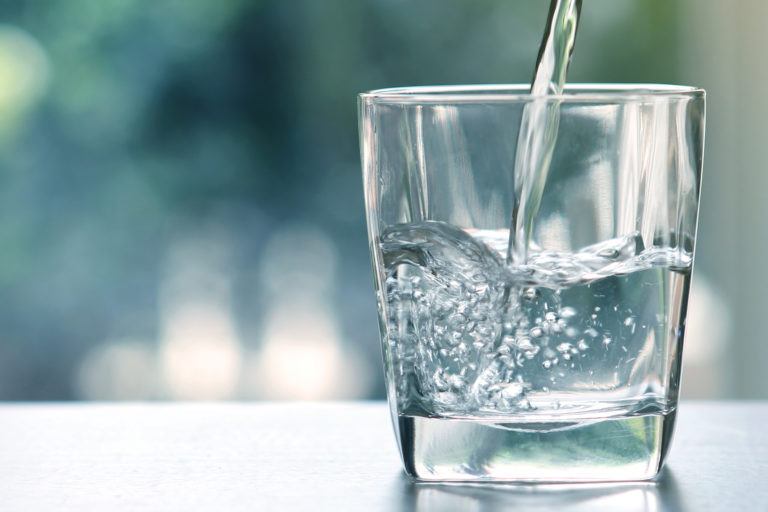
Quick Tips
- Activated-charcoal water filters are the most common of home filtration devices.
- Reverse osmosis is the scientific way of saying forced filtration.
- I was always told there was no point in drinking distilled water.
- There are three commonly used methods to clean water while camping.
- The alkaline water ionizer has become very popular recently.
- Wastewater treatment is not something the average consumer will ever be involved with.
Water is among humanity’s greatest needs. Of the world’s supply of water; 97% is in the ocean and 2% is frozen. This leaves just 1% of the world’s water left for drinking. When I see a statistic like this, I get the initial reaction that we all get: a bit of shock. But what exactly does that mean, 1%? How much water is that? How much do we need? It is a shocking statistic, but in itself it doesn’t mean much. I am not doubting that there is a water crisis. Maybe not in America but in other countries for sure. And perhaps someday we Americans will be faced with a water crisis. We already have a strange fascination with bottled water. Ooh, it’s from a rare mountain spring. Oh my God, what flavor!
Fortunately, a lot of people have gotten hip to this whole bottled water scam and discovered a way to make their own filtered water. The result has saved them loads of money, natural resources, and energy. There are a lot of ways to filter or clean water. Below I have listed all that I am aware of. I have also included the benefits and downsides for each.
Cleaning Water
 Activated-charcoal water filters are the most common of home filtration devices. They work by passing water through a cartridge of activated charcoal. The charcoal has been activated with oxygen, which makes it extremely porous. The porous carbon has a massive amount of surface area—300–2000 square meters per gram. This provides lots of bonding sites for impurities in the water, especially organic or carbon-based impurities and chlorine. This means that activated charcoal filters will remove certain impurities while letting others through. And once the bonding sites are full, the filter is useless and must be replaced. As far as getting your water to taste clean and fresh, it does the job. But stick to tap water, and never ever use it to filter non-potable water. It doesn’t remove bacteria and viruses.
Activated-charcoal water filters are the most common of home filtration devices. They work by passing water through a cartridge of activated charcoal. The charcoal has been activated with oxygen, which makes it extremely porous. The porous carbon has a massive amount of surface area—300–2000 square meters per gram. This provides lots of bonding sites for impurities in the water, especially organic or carbon-based impurities and chlorine. This means that activated charcoal filters will remove certain impurities while letting others through. And once the bonding sites are full, the filter is useless and must be replaced. As far as getting your water to taste clean and fresh, it does the job. But stick to tap water, and never ever use it to filter non-potable water. It doesn’t remove bacteria and viruses. Reverse osmosis is the scientific way of saying forced filtration. Osmotic pressure is the pressure it takes to move a solvent from an area of low solute concentration to an area of high solute concentration, to balance things out. So the reverse of that is forcing a solvent (water) to the other side of a membrane (filter) while leaving the solutes (impurities) on the other side. Reverse osmosis filters are designed to only let water through, which means along with the undesired impurities, you have also removed the minerals, which your body likes. But you can add minerals back into the water easily, as there is a bottle of liquid minerals that you can buy at the store. The process of reverse osmosis is most commonly used for desalinization—turning salt water into drinking water. They are becoming more popular in homes. My grandma has one, and she loves it.
Reverse osmosis is the scientific way of saying forced filtration. Osmotic pressure is the pressure it takes to move a solvent from an area of low solute concentration to an area of high solute concentration, to balance things out. So the reverse of that is forcing a solvent (water) to the other side of a membrane (filter) while leaving the solutes (impurities) on the other side. Reverse osmosis filters are designed to only let water through, which means along with the undesired impurities, you have also removed the minerals, which your body likes. But you can add minerals back into the water easily, as there is a bottle of liquid minerals that you can buy at the store. The process of reverse osmosis is most commonly used for desalinization—turning salt water into drinking water. They are becoming more popular in homes. My grandma has one, and she loves it. I was always told there was no point in drinking distilled water. Distilling water consists of boiling it, capturing the steam, and cooling it back to liquid form. It is commonly used for scientific research because it has no impurities, and it is used to fill humidifiers because it doesn’t cause lime scale. But some people say it has health benefits. They say because it has no impurities, it will remove impurities from your body. Water does do that, but is it really beneficial? One downside is you are robbing your body of essential minerals that are not found in distilled water. Plus, you have to buy distilled water. Unless you have your own distillery in your home. That would be kinda odd, though.
I was always told there was no point in drinking distilled water. Distilling water consists of boiling it, capturing the steam, and cooling it back to liquid form. It is commonly used for scientific research because it has no impurities, and it is used to fill humidifiers because it doesn’t cause lime scale. But some people say it has health benefits. They say because it has no impurities, it will remove impurities from your body. Water does do that, but is it really beneficial? One downside is you are robbing your body of essential minerals that are not found in distilled water. Plus, you have to buy distilled water. Unless you have your own distillery in your home. That would be kinda odd, though. There are three commonly used methods to clean water while camping. The first would be to boil it. Boiling will kill all microorganisms in the water, but it is time consuming and uses up fuel. The second is a water filter designed for removing bacteria and protozoa. Some filters come equipped with an iodine system for killing viruses. The third is to add a chemical tablet to kill all the microorganisms in the water. The chemical used is usually iodine and it make the water taste odd. The tablets are cheap, but they expire six months after being opened. I would boil the water, and then run it through a charcoal filter to get rid of the taste. It would be extremely time-consuming but worth it. If you are worried about toxins in your drinking water, be safe and pack water in with your other gear. None of these water purification methods are 100% effective at removing toxins.
There are three commonly used methods to clean water while camping. The first would be to boil it. Boiling will kill all microorganisms in the water, but it is time consuming and uses up fuel. The second is a water filter designed for removing bacteria and protozoa. Some filters come equipped with an iodine system for killing viruses. The third is to add a chemical tablet to kill all the microorganisms in the water. The chemical used is usually iodine and it make the water taste odd. The tablets are cheap, but they expire six months after being opened. I would boil the water, and then run it through a charcoal filter to get rid of the taste. It would be extremely time-consuming but worth it. If you are worried about toxins in your drinking water, be safe and pack water in with your other gear. None of these water purification methods are 100% effective at removing toxins.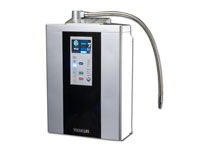 The alkaline water ionizer has become very popular recently. The deal with the ionizer is is changes water to 70% alkaline and 30% acidic. Water normally is half and half, giving it a neutral pH of 7. The alkaline water is touted as having health benefits. But the alkaline water become neutralized by the acid in your stomach anyway. And most water is absorbed into your system through your intestines. And your body makes all water alkaline before it absorbs it anyway. So exactly what this is supposed to do for us, I am not sure. The makers of the alkaline water ionizer have no scientific research to uphold their claims. It is pseudoscience at its best. Don’t buy into it. It’s a scam.
The alkaline water ionizer has become very popular recently. The deal with the ionizer is is changes water to 70% alkaline and 30% acidic. Water normally is half and half, giving it a neutral pH of 7. The alkaline water is touted as having health benefits. But the alkaline water become neutralized by the acid in your stomach anyway. And most water is absorbed into your system through your intestines. And your body makes all water alkaline before it absorbs it anyway. So exactly what this is supposed to do for us, I am not sure. The makers of the alkaline water ionizer have no scientific research to uphold their claims. It is pseudoscience at its best. Don’t buy into it. It’s a scam.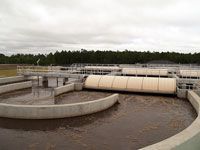 Wastewater treatment is not something the average consumer will ever be involved with. Except for, of course, supplying the waste, or sludge as it’s referred to in the business. Basically, wastewater is 99.94 % water, and the rest is, well . . . you know, poo. The first step is to sort out the sludge using screens. The poo is removed, ground up, and sent to a different area to be processed. The “water” continues on to the primary treatment. In primary treatment, the poo either sinks to the bottom or floats to the top. It depends entirely on your constitution and fiber intake. The next two steps involve an introduction of microorganisms that consume any remaining organic matter in the water. After all the organic matter is gone, they die and sink to the bottom. The last step involves either treating the water with chlorine or exposing it to ultraviolet light. Finally, it is discharged into a stream.
Wastewater treatment is not something the average consumer will ever be involved with. Except for, of course, supplying the waste, or sludge as it’s referred to in the business. Basically, wastewater is 99.94 % water, and the rest is, well . . . you know, poo. The first step is to sort out the sludge using screens. The poo is removed, ground up, and sent to a different area to be processed. The “water” continues on to the primary treatment. In primary treatment, the poo either sinks to the bottom or floats to the top. It depends entirely on your constitution and fiber intake. The next two steps involve an introduction of microorganisms that consume any remaining organic matter in the water. After all the organic matter is gone, they die and sink to the bottom. The last step involves either treating the water with chlorine or exposing it to ultraviolet light. Finally, it is discharged into a stream.
10 Ways to Conserve Water
- With toilets: “If it’s yellow, let it mellow; if it’s brown, flush it down.”
- With dishwashers: don’t rinse your dishes and only run the dishwasher when it’s full.
- Wash your car at a car wash. They are required to install filtration systems for wastewater and use only biodegradable soaps and waxes. The high pressure sprayers also require less water.
- Never put water down the drain when there may be another use for it, such as watering a plant, gardening, or cleaning.
- Insulate your water pipes. You’ll get hot water faster and avoid wasting water while it heats up.
- Take shorter showers.
- Turn water off while shaving and brushing your teeth.
- Keep water cold in the fridge so you don’t have to let the faucet run.
- Water your lawn only when it needs it.
- When you do water the lawn, soak it deeply, which means a little water over a longer period of time. It allows more water to penetrate the soil instead of just run off, and this means you won’t have to water as frequently.
Natural Water Cleaners
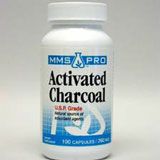 Activated charcoal or carbon is the what Britta, Pür, and many other companies use in their water filtration systems. The charcoal is activated with oxygen, which makes it extremely porous. The surface area of the charcoal is greatly increased, giving the impurities lots of places to bond with the charcoal, removing them from the water.
Activated charcoal or carbon is the what Britta, Pür, and many other companies use in their water filtration systems. The charcoal is activated with oxygen, which makes it extremely porous. The surface area of the charcoal is greatly increased, giving the impurities lots of places to bond with the charcoal, removing them from the water.
 Ultraviolet light in high intensity is used at wastewater treatment facilities, saltwater aquariums, and homes to kill bacteria, protozoans, and viruses. The light rearranges the DNA and RNA of the pathogen, rendering it incapable of reproduction. Effectively dead.
Ultraviolet light in high intensity is used at wastewater treatment facilities, saltwater aquariums, and homes to kill bacteria, protozoans, and viruses. The light rearranges the DNA and RNA of the pathogen, rendering it incapable of reproduction. Effectively dead.
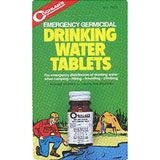 Iodine tablets have been around for a long time as a simple means of making non-potable water drinkable. The iodine kills everything in its path. It is both an effective and cheap treatment. However the iodine has a tendency to make the water taste a bit off. And once the package of tablets has been opened, they only have a six-month shelf life. So keep that in mind, but you can order a pack of Coghlan’s Emergency Tablets from Amazon.
Iodine tablets have been around for a long time as a simple means of making non-potable water drinkable. The iodine kills everything in its path. It is both an effective and cheap treatment. However the iodine has a tendency to make the water taste a bit off. And once the package of tablets has been opened, they only have a six-month shelf life. So keep that in mind, but you can order a pack of Coghlan’s Emergency Tablets from Amazon.